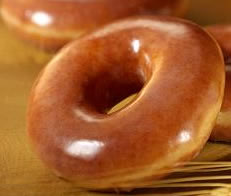Krispy Kremes Light Up The Brain
 OK, I admit it… if this story was about rats and food pellets, it wouldn’t be particularly compelling. But when scientists decide to see what your brain does while it’s looking at Krispy Kreme donuts, that’s news! Neuroscientists at Northwestern University, as part of an effort to understand how stimuli affect our brains in various motivational contexts, have examined how images of food work on our brain when we are hungry:
OK, I admit it… if this story was about rats and food pellets, it wouldn’t be particularly compelling. But when scientists decide to see what your brain does while it’s looking at Krispy Kreme donuts, that’s news! Neuroscientists at Northwestern University, as part of an effort to understand how stimuli affect our brains in various motivational contexts, have examined how images of food work on our brain when we are hungry:
In the study, subjects were tested twice — once after gorging on up to eight Krispy Kreme donuts until they couldn’t eat anymore, and on another day after fasting for eight hours.
In both sessions, people were shown pictures of donuts and screwdrivers, while researchers examined their brains in fMRI’s.
When the subjects saw pictures of donuts after the eating binge, their brains didn’t register much interest. But after the fast, two areas of the brain leaped into action upon seeing the donuts. First, the limbic brain — an ancestral part of the brain present in all animals from snakes to frogs to humans — lit up like fireworks.
“That part of the brain is able to detect what is motivationally significant. It says, not only am I hungry, but here is food,” said senior author Marsel Mesulam, M.D., the Ruth and Evelyn Dunbar Distinguished Professor of Psychiatry and Behavioral Sciences at the Feinberg School and a neurologist at Northwestern Memorial Hospital.
Next, the brain’s spatial attention network shifted the hungry subject’s focus toward the new object of desire — in this case the Krispy Kremes.
“There’s a very complex system in the brain that helps to direct our attention to items in our environment that are relevant to our needs, for example, food when we are hungry but not when we are full,” said Aprajita Mohanty, lead author of the paper and a post-doctoral fellow at the Feinberg School. [From Northwestern University – Your Brain on Krispy Kremes.]
(“Donuts and screwdrivers” may sound like a fraternity house breakfast, but I believe the researchers used photos of tools, not OJ and vodka cocktails.)
Two neuromarketing aspects of this work are apparent, if not particularly surprising:
- Images of food activate the brain in the same way that the actual presence of food might.
- The intensity of activation is dependent on the level of hunger.
Needless to say, the blogosphere is buzzing with discussion of the startling news about starving people looking at donut photos. The ever-vigilant NeuroCritic pokes fun at the painfully obvious findings, as does CNBC’s Jane Wells: “More earth-shattering research news from our nation?s universities! … When you are hungry, you react more strongly to images of food than when you are not hungry. Who knew?” Cassy Fiano, in a post titled, It’s not your fault you stuff your face with Krispy Kremes! says that it actually IS your fault: “If you stuff your face with Krispy Kremes, it’s not because you’re a slave to the primal urges of your brain, it’s because you wanted to.” Marc Dingman at Neuroscientically Challenged concludes pragmatically, “I suppose the greater task in our corpulent society right now, however, is to learn how to avoid those Krispy Kreme donuts instead of to understand exactly how our brain focuses attention on them.”
The study appeared in the online version of Cerebral Cortex. There’s no word on whether the next study will try to determine if Krispy Kreme’s iconic “Hot Now” neon sign will light up the brain in the same way as the actual donuts, or if photos of steamed broccoli produces brain activation levels similar to that caused by images of chocolate-laden donuts.
